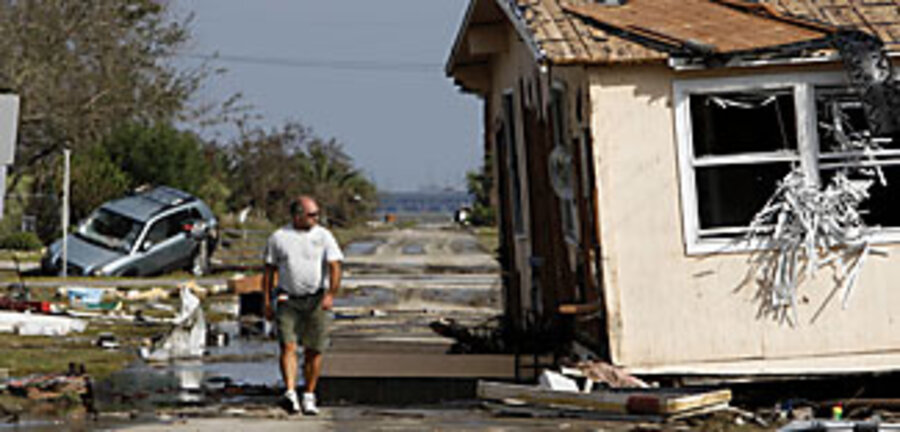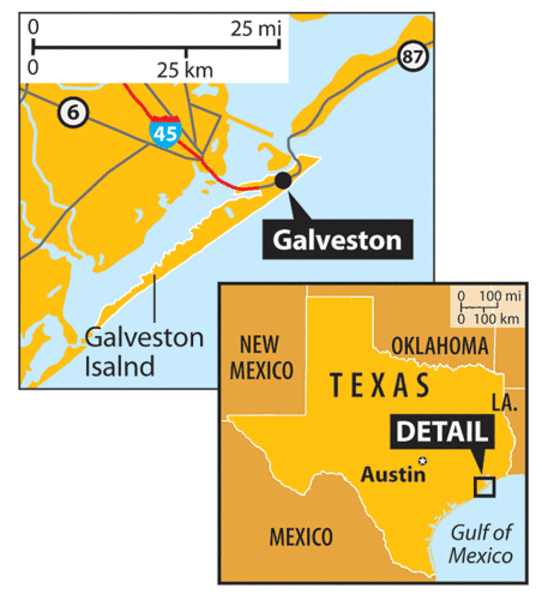After Ike, to rebuild or not?
Loading...
| Galveston Island, Tex.
Wrecked sailboats and shrimpers litter Galveston Bridge. Pilings from 30 blown-away beach homes stick out of the water, the beach gone. The historic haunts where Frank Sinatra and the rest of the Rat Pack once congregated – disintegrated by hurricane Ike.
But safely ensconced behind a 10-mile long seawall built after a catastrophic 1900 hurricane, native Galvestonian Andrew Shelton took barely a lick from Ike. On either side of the seawall, however, a 12-foot storm surge claimed perhaps hundreds of recently built homes with beach access and million-dollar views.
The contrast, says Mr. Shelton, reveals the folly of an exuberant coastal policy that has allowed taxpayer-subsidized market forces to place some of the nation's most valuable real estate on the coast's most unpredictable perches.
"The irony of this storm is that rich people who built outside the seawall got wiped away and the lower economic classes who trust the seawall survived," says Shelton, whose great-great-grandfather, John Henry Hutchens, survived the 1900 hurricane, which killed more than 6,000 islanders.
As the unprotected West End neighborhoods of Galveston Island remained impassable, and news came that much of Bolivar Peninsula to the east, also unprotected, had borne the brunt of Ike's massive wall of water, questions are being raised about the storm's impact on coastal development.
"I think people are now going to weigh carefully their investments, whether it's in terms of industry, business, and government," says Heber Taylor, editor of the Galveston County Daily News, Texas' oldest continuously published newspaper.
With President Bush visit to the island Tuesday, it's a debate that's likely to focus on Galveston, where storm memories run deep in the island's colorful and multi-cultural heritage, and where recent decades have seen political and market shifts that seem to contradict the hurricane lessons learned, and still practiced, by many natives.
On the other side of the debate is the notion that coastal development is no riskier than building in wildfire-prone California hills or along Tornado Alley in Kansas, with few critics questioning the right of residents there to receive federal insurance and rebuilding aid.
Hurricane Katrina in 2005, with its $130 billion federal aid package, began shaping that debate in earnest, sparking deep reforms in required construction practices. In some beach towns in and around Galveston Island – including Bolivar, Rollover Pass, Crystal Beach, and Gilchrist – Ike may now define how Texas decides to draw both physical and philosophical lines on beach-building.
Even before the storm, Texas Land Commissioner Jerry Patterson proposed that new coastal construction be set back at 60 times the erosion rate – 60 feet for every foot of erosion, for example.
"We now have a graphic example of why you should build as far away from the dunes as possible," Mr. Patterson told the Houston Chronicle during a flyover.
Local officials blasted Patterson's proposal, claiming that communities couldn't survive without new construction. The late '90s real estate boom helped fill tax coffers at a time when local industries were declining – especially in old boom towns like Galveston.
So far, the federal government has largely sided with building boosters. In high-erosion corners of the Gulf like Dauphin Island, Ala., the Army Corps of Engineers has moved sand in order to replace home lots that washed out to sea. Generous infrastructure funds guaranteed by federal law allow the government to underwrite disaster recovery, and also tend to support rebuilding on vulnerable lots.
"It's a very positive sign for sensible management if the State of Texas does take a new look at how we rebuild extremely vulnerable shorelines," says Rob Young, director of the Program for the Study of Developed Shorelines at Western Carolina University in Cullowhee, N.C. "But I'm also skeptical, because the people who are being shut out of rebuilding tend to be wealthy and politically influential. People say, 'Those people must be nuts to build on the West End of Galveston,' but it's actually the taxpayers who are nuts for subsidizing that development."
Alphonso Nickerson, who rode out Ike with his mother behind the seawall, says wealthier residents will certainly rebuild. "If you don't have to worry about money, it's no big thing," he says.
But Carlos Silliman, a laid-back outdoorsman, says city government has abandoned the lessons of the last half-dozen storms. He thinks the city should stop building infrastructure to the unprotected areas and pay more attention to storm-proofing the city's five electrical substations, all of which fizzled out.
"Yes, these kinds of storms become memorialized and they become part of that culture," says Anthony Oliver-Smith at the Institute for Environment and Human Security at United Nations University in Bonn, Germany. But he says, "Memories of [natural disasters] begin to diminish after 30 years, at which point development begins again to put people in harm's way."






